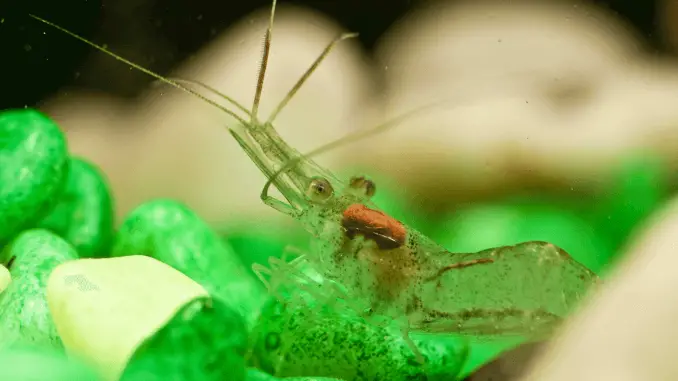
The ghost shrimp is a freshwater shrimp of the Palaemonetes family. This species is small and primarily clear in color, which is why it got its name.
These shrimp are popular among aquarists because the shrimp are easy to care for and act as tank cleaners.
Ghost shrimp make the perfect addition to any tropical community consisting of other small non-aggressive fish.
TABLE OF CONTENTS
Ghost Shrimp Facts & Overview
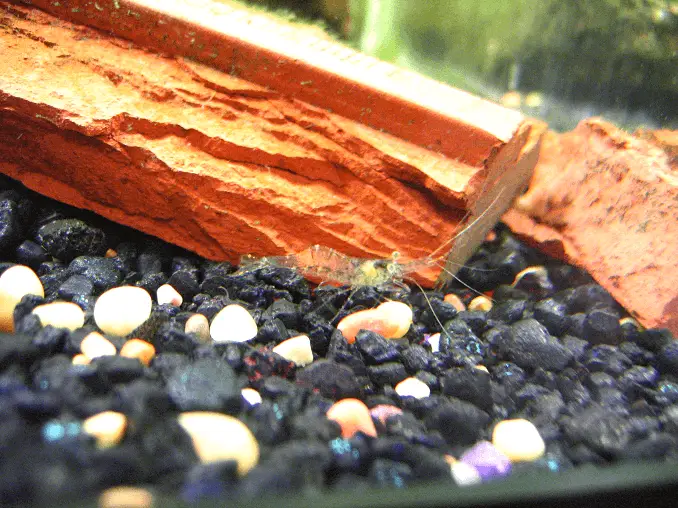
| Scientific Name: | Palaemonetes paludosus |
| Common names: | Ghost shrimp, glass shrimp, eastern glass shrimp |
| Distribution: | North America |
| Size: | 1.5 inches |
| Life expectancy: | One year |
| Color: | clear |
| Diet: | Omnivore |
| Temperament: | Peaceful |
| Minimum tank size: | 5–10 gallons |
| Temperature: | 65–82°F (23–28°C) |
| pH: | 7.0–8.0 |
| Hardness: | 3.0–12.0 dGH |
| Care level: | Easy |
Origin
Although ghost shrimp fossils suggest this crustacean’s existence in the Cretaceous and Jurassic periods, these tiny crustaceans were first described in North America in the 1850s.
Ghost shrimp can frequently be seen on sand beaches and coastal regions around the Pacific Ocean.
Adult Size & Life Expectancy
Adult ghost shrimp grow up to 1.5 inches long. Females can grow up to 2 inches long.
A lifespan of only one year means these small shrimp aren’t known for their longevity.
Availability
Ghost shrimp are available at most pet stores, especially stores specializing in aquatic creatures. They typically cost $0.50–$3 per shrimp.
You can buy this freshwater species at AquariumFish or Aquariumfishsale.com.
Appearance & Behavior
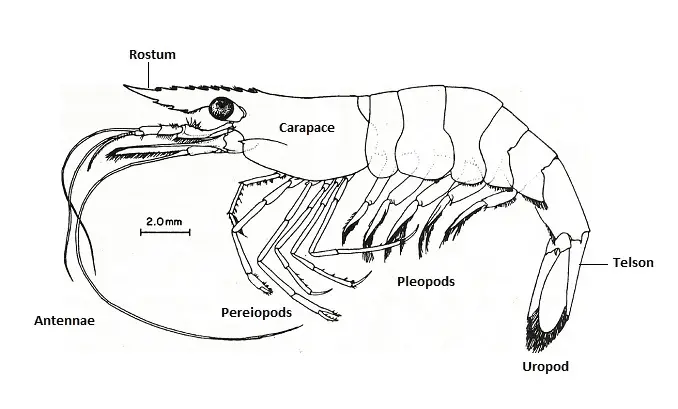
The ghost shrimp’s transparent body gives it a quirky appearance — especially since the clear body allows others to see what the shrimp have eaten that day.
This species’ peaceful and shy nature makes the ghost shrimp an ideal tank companion for other peaceful species.
Colors, Patterns, and Size
Ghost shrimp are transparent. This unique physical characteristic helps these shrimp avoid predators and makes the species attractive in any aquarium. This species doesn’t vary in color, but some ghost shrimp have colored spots on their back. Females develop green markings on their sides when approaching puberty.
Ghost shrimp are small. Females grow up to 2 inches long, but males only grow 1.5 inches. Unlike fish, ghost shrimp don’t have fins and use their tails to move.
This species molts regularly, as it grows too large to fit its shell. When these small shrimp shed their shells, they’re especially vulnerable until the new shell grows. During this time, keep your ghost shrimp away from any boisterous fish to avoid injury.
Typical Behavior
Ghost shrimp are known for being passive and peaceful, making them the ideal tank mates for busy tanks with many other species.
These shrimp can be found swimming around the middle of the tank or cleaning leftover food and algae from the bottom. They tend to stay active and busy during the day and occasionally burrow in the sand.
While this tranquil species enjoys being in a group, a single shrimp will survive happily on its own.
Ghost Shrimp Tank & Water Requirements
Any aquarist hoping to house a ghost shrimp should ensure the shrimp’s tank is consistently warm and has a capacity of at least 5 gallons.
Habitat and Tank Requirements
Ghost shrimp enjoy decorations such as driftwood, rocks, and sand. Only use rounded rocks in the tank, as sharp rocks can injure the shrimp’s exoskeleton.
Avoid nitrates accumulating in the tank. To remove nitrates from the tank’s water, introduce fast-growing floating and root-feeder plants to the tank.
Avoid plants with sensitive roots, as the shrimp’s burrowing habits may damage them.
Water Conditions
The ideal tank conditions for a ghost shrimp should be as follows:
| Water type: | Hard, freshwater |
| Tank size: | Minimum 5 gallons |
| Water temperature: | 68–82ºF |
| Acidity: | 7.0–8.0 pH |
| Water hardness: | 10–15 dGH |
| Water supplements: | Calcium |
The tank conditions for a ghost shrimp should mimic the shrimp’s natural habitat — warm freshwater, with a layer of sand at the bottom and a range of plants to enjoy.
Ghost shrimp don’t require excessive filtration — purchasing a filter to match the size of your tank is sufficient, and a sponge filter is ideal. The shrimp enjoy swimming in the bubbles created by an air pump.
Avoid creating a current that’s too strong, inhibiting your shrimp’s ability to swim.
Care & Diet
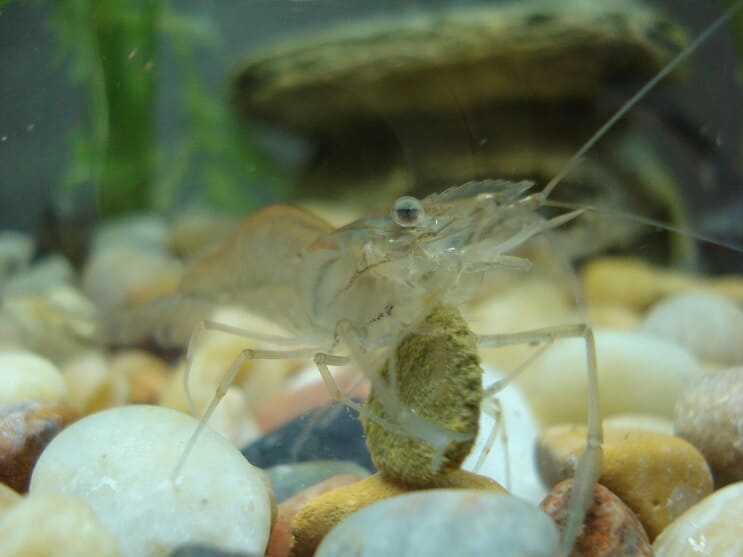
Caring for a ghost shrimp is relatively easy. These shrimp enjoy a varied diet, including algae off the side of their tank.
Ghost shrimp’s delicate exoskeleton increases their risk of injury, so keep your shrimp’s tank free of sharp decorations.
Diet and Feeding
Feed your ghost shrimp a diet consisting mainly of algae, aquatic plants, larvae, weeds, and pellet foods. It’s also worth feeding ghost shrimp calcium supplements to help them form a hard shell.
Due to the shrimp’s small size, these crustaceans only require small amounts of food, most of which they can acquire from their tank mates’ leftovers. If you keep your ghost shrimp alone or just with tank mates of the same species, you’ll need to give them their own food.
The amount of food the shrimp require depends on how much algae is in the tank. The more algae there is, the less you’ll need to feed them.
A group of four shrimp needs feeding once every other day, and just one ghost shrimp only requires food once every few days. This species’ scavenging nature means you don’t need to be too strict with its feeding routine.
General Care
Caring for ghost shrimp is straightforward because of their lack of stringent feeding needs, relatively small tank size requirement, and peaceful nature.
Supplement your ghost shrimp’s food and water with calcium to keep their shell strong. Bright lights and access to hiding places within the tank will keep this species entertained.
Common Problems
Ghost shrimp react negatively to improper water conditions, such as pH outside of the 7–8 range, or the presence of ammonia in the tank. The shrimp are also particularly susceptible to the vorticella parasite and several bacterial infections.
Vorticella is a parasite that appears as a white fungus on the ghost shrimp’s tail and the tip of their nose. This parasite may cause a loss of appetite and energy in ghost shrimp and can be treated with aquarium salt and a good filter.
Bacterial infections will appear as a pink, swollen spot on a ghost shrimp’s body. Unfortunately, bacterial infections are usually fatal for ghost shrimp, so the best course of action is to separate the infected shrimp from their tank mates to stop the infection from spreading.
Is a Ghost Shrimp Dangerous?
Ghost shrimp are not considered dangerous. However, aquarists should avoid keeping too many of these shrimp in a tank together, because the species can become aggressive and attack its tank mates when it has to fight for space.
Tank Mates
Ghost shrimp make ideal tank mates for small, calm, bottom-dwelling fish, due to both species’ shy and non-aggressive natures.
These tiny crustaceans’ size makes them vulnerable to being eaten, so avoid pairing them with large predators.
Ideal tank mates for ghost shrimp include:
- Cherry shrimp
- Amano shrimp
- Kuhli loaches
- Freshwater snails
- Cory catfish
- Vampire shrimp
Lifespan and Molting
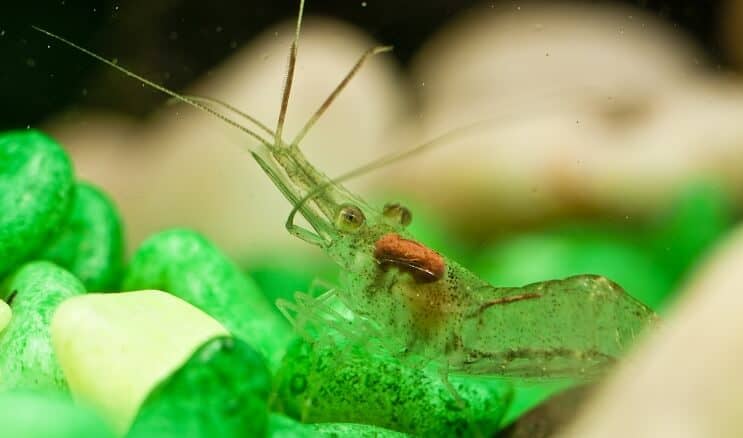
Ghost shrimp live for around a year, but this can vary depending on the individual and the place of origin.
Because they are so cheap and easy to breed, these shrimp are often used as feeder fish for larger species in the home aquarium, and as a result, are often kept in high densities with poor filtration.
This makes them more likely to die during transport and increases their mortality rate. It is common for some individuals to die a few days into life in their new tank, even if the tank is perfectly healthy.
Although their lives are short, ghost shrimp molt regularly as they eat and grow, becoming too large for their previous shell. This can become fairly frequent. It all depends on how much they eat and how fast they grow.
Once ghost shrimp have shed their old shell, they will be particularly vulnerable until their new shell hardens. While you don’t need to worry too much during this time, don’t be surprised if your ghost shrimp takes damage through rough behavior from boisterous fish.
Ensure that your tank has crevices and plants for molting shrimp to hide in.
When you see a molted shell sitting on the sediment, it’s natural to panic and assume it’s a dead shrimp. However, upon closer inspection, the hollow interior of the husk should clearly identify it as a discarded exterior.
When your ghost shrimp sheds its shell, you don’t need to remove it from the aquarium immediately because it will usually become food for other shrimp in the tank.
Breeding
Ghost shrimp are easy to breed provided they’re kept in a healthy environment without predators. For an optimal chance of breeding, stock the tank with twice as many females as males. You can establish which shrimp are female by their larger size and green saddle, located under their bodies.
To simulate the shrimps’ warmer mating months and encourage breeding, raise the tank’s temperature to around 80°F. After a few weeks, the females will produce eggs, which will appear as green dots around their legs.
Allow a few days for the males to fertilize them. Having high levels of calcium in the tank will improve the chance of these eggs maturing.
Once the eggs are fertilized, move the females to a different tank to allow the young to hatch, as ghost shrimp have been known to eat their own young.
The babies’ environment should match the main tank, with a thin layer of sand and some smooth decorations. Adding a robust sponge filter to the tank will ensure none of the young get sucked into the aquarium’s equipment. Feed the baby shrimp small amounts of particle food until they grow legs, at which point you can feed them the same diet as an adult ghost shrimp.
Shrimp are fully grown at five weeks old, at which point you can move them back to the main tank with their parents.
Should You Get a Ghost Shrimp for Your Aquarium?
If you’re looking for a crustacean with a unique appearance and peaceful nature, a ghost shrimp is ideal. These tiny shrimp will not only entertain you with their energetic antics, but they’ll also keep the tank clean and free from algae.
The ghost shrimp’s small size and ability to get along with tank mates make this crustacean a fascinating addition to any aquarist’s tank.
Ghost Shrimp FAQs
- Can ghost shrimp live with neon tetras?
- How do you keep ghost shrimp alive?
- Can ghost shrimp live with guppies?
- Can a ghost shrimp live with a betta?
- How many ghost shrimp can I put in a 10-gallon tank?
- Can ghost shrimp live alone?
- Why is my shrimp dying?
- Is my ghost shrimp dead or molting?
- Is it ok to leave dead shrimp in the tank?
- Is my ghost shrimp male or female?
- Can ghost shrimp live without a heater?
- Why do ghost shrimp jump out of water?
- Why do ghost shrimp turn white?
- Why are my ghost shrimp dying?
- How long do ghost shrimp live for?
- Should I remove dead ghost shrimp?
- What conditions do ghost shrimp need?
- Will ghost shrimp clean my tank?

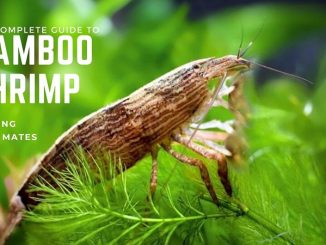
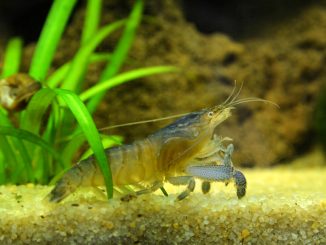
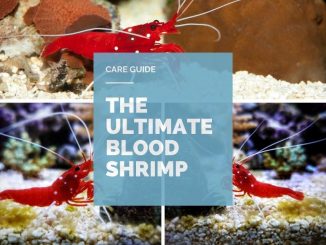
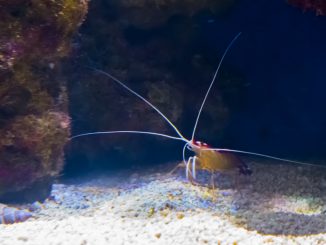
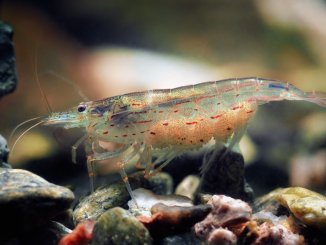
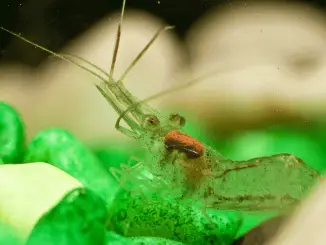
I have some questions about keeping ghost shrimp. I started a small tank, in anticipation of housing a betta, but I have not done so yet. i established a zebra snail, tiger snail, and three ghost shrimp to cycle the tank. I ended up with two female shrimp who had eggs and one small male to start. I can see the two females and they have since lost their eggs, but the male has been hard to find. I did a water change today and I’m not sure if I have a shed (stuck to a live plant) or a dead male. I can see the two females. At this point I’m more interested in making sure that my water quality is good before I even think about adding a betta. I’m also worried about the shrimp. I’ve done water changes and checks. I had some teak wood in the the tank that I hoped would lower the hardness, but it lowered it way more than I thought, even after doing water changes. I took the teak out, but I’m not sure where to go from here. I’ve been testing the water and my water is still too acidic. I’ve been working on going through the cycle of the tank, but in every test, my nitrate and nitrite level is low. Chlorine is zero. I don’t really know where to go from here. Right now, I’m looking at making sure I can take care of ghost shrimp before I even introduce a betta. I’m not sure what I’m doing wrong with cycling the water. Any advice/help would be appreciated. Thank you!
Hi Sarah,
Thanks for your message. We always recommend that you do fishless cycle (including other aquarium animals too). It may take slightly longer but it is always safest for all the fish/invertebrates involved.
Since you have already cycled your tank with shrimp and snails, all I can do is advice you from here, but if you ever happen to cycle a tank again, don’t put any creatures into it. You can read more about setting up your first tank in our article here: https://www.fishkeepingworld.com/how-to-set-up-a-fish-tank/
Great that your chlorine levels are at 0. Your nitrite levels need to be at zero too, and your nitrate levels should be low (you carry out water changes to keep these low).
Just wait until your nitrite levels are down. You tank needs to build up a specific bacteria which converts the ammonia to nitrites. Once this has been established, you’ll see the nitrite levels coming down.
With regards to the acidity problem, have you checked your regular tap water? While it’s unusual for tap water to be acidic, this does happen from time to time. If you’re sure it’s the wood you’ve put in (some wood can alter the pH of the water), you can boil it to remove the toxins. In the meantime, there are plenty of products you can buy to raise the pH, just make sure you do it really slowly to stop your current inhabitants getting stressed.
Keep an eye of the shrimp on the plant, and just take it out in a few days if you’re sure it’s dead (or just the shed exoskeleton).
Robert
When the ghost shrimp dies, it usually takes on a peach colour, I have found this out by breeding and online.
oh wow. today I found a clear shrimp shed, but at the time I thought it was a dead shrimp. I was freaked about until I saw a page about ghost shrimp molting. thanks for the description though! should be helpful.
Don’t do water changes, Toncontrary believe water changes aren’t good for your tank. Keep the water you have for an extended time, get a pleco in there as well as some Cory cats, there a dirtier fish but they will help you get your water right, there also very hard to hurt or kill as they adapt quickly to there New tank.
Absolutely wrong…
Hi, I’ve recently lost a ghost shrimp that had difficulty molting, what can I do to prevent this in the future. I’d like to breed them with minimal loss.
Common causes of that impact molting are GH, KH and TDS. Check that your water parameters are all at the levels they’re supposed to be at.
Robert
I am wondering- how many babies can a ghost shrimp have at a time? I have tried google, but it says everything BUT what I searched for.
They usually carry 20-30 eggs at any one time. Thanks Robert
Thanks
Are ghost shrimp okay to keep with guppies?
Hi Anna, yes ghost shrimp are fine to keep with guppies. You can read more about keeping guppies on our care guide here: https://www.fishkeepingworld.com/guppies/ Thanks, Robert
Are ghost shrimp okay with goldfish?
Hi Ella, they might be OK being kept with slower fancy goldfish varieties? Which goldfish do you have? Thanks, Robert
I just purchased 3 ghost shrimp and in less than an hour my 2, 3 inch koi fish gobbled them up. The 3 smaller gold fish seamed to be less interested. I am going to buy more shrimp tomorrow because I feel they should be able to survive in my aquarium because there are plenty of rocks and plant to hide in and around. I did a lot of rearranging and stirring up in the process and they were possibly struggling to maintain a safe shelter.
I had a Betta in a 1/2 gallon ‘betta tank’ for two weeks until I did some research on why he was lethargic and found out they need more! And filtration and airation…
So I set up a little 3.5 gallon bio bubble…horrible little tank, has a wicked current and it’s an absolute pain to do water changes or anything else you need to do.
So I bought a new 10gallon tank with all the fixings (whoever said betta’s are a cheap fish don’t do it right!), Did the cycle, added the Betta and a snail I had got the the 3.5g, a week later added 3 Cory catfish and a week later added 3 ghost shrimp (the store said they went well together). The Betta has left everyone alone though and seems happy in his tank with the others. I’m wondering if I could get a few more shrimp and if so should I stick to the ghost shrimp or could I get others?
My water is hard
GH 180
KH 180
PH 7.5
NO2 0
NO3 0
Hi Jennifer, the reason ghost shrimp work so well with Bettas is that they are see-through and so don’t attract too much attention. You could keep other shrimp with them with caution such as cherry shrimp (https://www.fishkeepingworld.com/cherry-shrimp/) or amano shrimp (https://www.fishkeepingworld.com/amano-shrimp/). Thanks, Robert
My beta killed ghost shrimp and snails
I have two pregnant ghost shrimp and I’m wondering how the process of having the babies will be if I do not separate them into an isolation tank. How many are likely to survive and how long until they are big enough to see so that I can clean the tank without killing those that survive?
Hi Trisha, I wouldn’t recommend keeping them in a community tank, or even with the mother once they’re born as they’re extremely likely to be eaten. Thanks, Robert
There are these small clear things attached to one of our fake plants that have been there about 2 weeks. They appear to be growing but they’re still so small it’s hard to tell. We had a berried female ghost shrimp so could these be her babies? They’re not swimming or floating around; they’re just attached to the plant and too small to make out any features although they are clear. How fast do the babies grow?
Hi Emily, The eggs normally stay attached to the mother until they are ready to hatch (around 21 days), she will then flick them off so it is possible that what you’re seeing are tiny shrimp. They’re barely even visible for the first few weeks. If your tank is well established there will probably be enough algae in there for them to eat, if not you’ll need to add some power based feeds such as spirulina. They should be fully grown within 5 weeks. Thanks, Robert
So I have a small 5 gallon tank, I did a creatureless cycle then added my snail and ghost shrimp, about 2 monthsater (4 days ago) I added one more ghost shrimp and a few small chili rasbora. As was well, unfortunately now I cant find my shrimp! My 4 year old and I have been searching in the tank. I do have a few plants and a little wood for them to hide but it’s been two days with no shrimp.sightings. is this normal? I feel like this is a dumb question but how could my little shrimp just disappear?
Hi Erika, do you have many hiding places in there? It’s very likely that he is hidden away! Thanks, Robert
I’m shocked to read that the lifespan is around a year. My little guy had been with us for at least 3 years now! The neighborhood kids have named him Mr. Professor and love trying to find him. When they can’t, they say he’s gone to his laboratory in the “basement” of the tank. Haha. How lucky are we to have had him for so long?!!!
I’ve been wanting to get some shrimps for weeks now to deal with dead plant matters (lots of new moss but isn’t doing too well probably cuz of algae) and was shocked that no one in the big fish club have any Cherries. I found some rare blue but shipping is outrageous when it should be free. Finally, with the mosses getting worse, I just had to grab some shrimps and the Ghost are the only option/color at PetsMart. Was surprised at them being only 39¢ and I grabbed all 8 that they had. Now they are in the tank with no problem so far with my sweet Betta. He isn’t bothering them. I’ve saw one went face to face with him and he was totally chill. Another rode on his back, lmao!!! Hope it doesn’t take long to see results for them to eat the dead/decaying brown stuff of the mosses.
I read that you could put shrimp with Betas so I did. I don’t know how many I’ve put in there total but I’ll say this, only 3 ghost shrimp have survived and 0 colored shrimp survived. The colored shrimp seem to disappear within 1-2 days. I finally have a shrimp only tank now with 1 pregnant female and I think I just got 2 more females. But I need more tanks cause I want to separate all the colors so I don’t end up with brown or grey shrimp. I also am concerned about moving my pregnant female because I’m afraid it’ll stress her out too much and because I don’t like the idea of having her in a breeder box for weeks. I had her in this tank by herself for weeks hoping she would have them before I got any more shrimp but I gave up thinking she was ever going to have them. But I know I’m an impatient person so maybe it just hasn’t been long enough. Hopefully I can get another tank set up before she has them so she doesn’t have to go in a breeder box! Just thought I’d share my experience with shrimp and Betas. Btw, my Beta didn’t start eating them until I put the colored ones in there with him.
I have a pair of ghost shrimps I noticed she was carrying eggs in her belly I put her in a tank on her own waited for her dropping the eggs but I cant find them what am I doing wrong thanks
Hi Helen, did you allow time for the male to fertilize the eggs before moving her? Thanks, Robert
I bought three ghost shrimp for my African dwarf frog to eat. He hasn’t eaten them yet, but I noticed that one of them was pregnant a few days ago. Now there is a cluster of semi see through things. They are piled up on the bottom of the tank and they each have little black eyes but they do not move at all. There has to be at least 30 of them. Is this the baby ghost shrimp?
Hi Angelle, when you say she looked pregnant, what did you see? Shrimps carry their eggs and in this species, they’ll be a greenish color and will be attached to the shrimps legs. Thanks, Robert
I dont know if anyone is still keeping up on this page, I just bought 48 ghost shrimp to breed and start feeding my Gold, turquoise, green, Severums. Plus one Oscar. They are in a separate tank and hopefully when the mother gets eggs I’ll move them to another separate tank with a sponge filter, so the little ones survive! This article was really helpful, anymore tips for breeding in large amounts such as the 48 I got.
We have two yellow belly sliding turtles that we would like to get some ghost shrimp to help with upkeep of the tank. Do you have any advice on how to clean the tank once we introduce the shrimp? We have to change their water currently about once a week, every two weeks at most. I’m hoping this will extend the time unless this is the norm? As novice aquatic pet keepers, any information you can help with would be greatly appreciated!!
I have a few ghost shrimps in my guppie tank. One of my shrimps has turned a beige color. I read that she is having issues with molting and that I need to add Iodine to my water. Is this true?
I have an online friend who claims to have a 6 yr old ghost shrimp. Is this some kind of record for longevity?
I’ve been keeping Ghost Shrimp in my 65g community as cleaners and critters of interest.
I have a well planted tank with lots of hides for both fish and invertebrates.
This morning, I spied two tiny sets of antennae belonging to two 1/2 centimeter juvenile shrimp! Against all odds, they are maintaining numbers.
And, I have a renewable and constant food source for my fish, namely my Peacock Gudgeon Gobies :-)>
Hi Leigh Ann, as a turtle keeper myself, all my life, I would like to know size of tank, diet etc. I would think ghost shrimp would be eaten as soon as they could catch them. You should have a basking place with a uvb/uva light bulb. An overturned clay flowerpot with a flat Rock works well if your turtles are still small. A clamp lamp with a reptile bulb directed at the basking rock works and is cheap. There are internal filters made for turtles, but I use a powerfilter that hangs on the top of the tank, because I have my water level a few inches from the top of the tank. I also have a full hood with a long turtle bulb. You can feed dark lettuces, crickets, earthworms etc. I cut up fish and raw shrimp in bite-sized pieces, and put reptile vitamins on it. I freeze it in snack size bags, in meal size portions, or amt you can use in a couple days, if you have little guys. A couple feeder goldfish are good clean-up buddies until the turtle gets them. Vary the diet, keep them warm, (submersible heater a must) scoop out leftover food,if you don’t have goldfish, and they should live many years. Hope this helps!
I would advise leaving the molts in the take, as the shrimp will often eat them to regain some minerals they lose
can you change their colors?
Hello. I have some ghost shrimps in my aquarium, some of them are peaceful , some of them are not. They went after my guppies… Is this behavior natural for the shrimp?
Do Ghost Shrimp go well with Black Neon Tetras
Will my clown loaches eat my ghost shrimp if I put them in the same tank?
I have had a ghost shrimp for about 8 months and I just got a new betta fish in my tank to replace my other that had died. Twice now I have found the ghost shrimp up on the side of the tank out of the water. I have managed to get it back into the water and it seems like it is fine. Is the poor thing completely traumatized by the betta fish. It got along (seemingly) with the other betta fish. Any suggestions? Thanks!
Do ghost and cherry shrimp make noise? I have been noticing a cicada like noise coming from my tank and wonder if it’s them.
I got a 30 gal tank,I started with 12 wild caught ghost shrimp, 3 crawfish, and 2 turtles, (one red ear slider and one yellow belly slider), all plants and rocks are from the wild, nothing store bought except food. I now have too many shrimp and 7 crawfish. Still got the turtles also. Plenty of hiding spots and bigger river stones make great crevices for them to hide. I think the turtles enjoy the shrimp cleaning there shells. The shrimp are just as cool to watch as the turtles are. Thanks for the tips about the Ph,
Info good and helpful, however, not so fast to give bettas bad wrap please. I have a solo male Koi in 10 gallon w/10+ ghost and solo female Koi in 2.6 gallon w/several ghost. Everyone gets along just fine. When I approach tank to feed male, the shrimp and betta rise to the top for food and all done peacefully together. It’s fun to watch while I can rest my tank kept clean and nitrites low to none. My advice: research the temperament of your betta especially if male. Like people, bettas have unique personalities too. My understanding Koi most docile.
Hey everyone..I have a question…I have 2 tanks for my shrimp bc one has the two moms n one dad n the other is all my beautiful but still very micro sized shrimp babies…the parents tank is fine but my babies tank is super cloudy. I have a few plants in the babies tank but I can’t figure out why it looks so cloudy or “dirty”. I checked my levels and only thing that’s reading a bit higher than usual is the nitrites…any ideas how to safely reduce that? I have quite a few babies and don’t wanna lose any if possible! (They are pets not food) also if anyone can recommend a good filter for the babies tank n where to look that be great! I had to make a filter to go over the intake so my babies didn’t get sucked in bc I can’t find any anywhere near me…Thank you so much for your time!
I had a berried ghost shrimp about a month ago. The eggs hatched in the tank with other fish because I didn’t want babies and didn’t separate them. After about a week, I saw the larvae floating around and a week later, I saw about 3 babies crawling on the gravel. They were big enough to not be eaten. Then, they dissapeared and I haven’t found them since a few days ago. Where could they have gone?
I have a 55 gallon tank with a large cascade filter and 2 underwater gravel filters. A grate underneath the gravel, usual old time setup. Just seemed an offbeat, not the usual tank set-up these days.
I have kuhli loaches, bristlenose plecos, bronze corydoras and just added 10 small mystery snails.
I want to add some more fish, I am thinking about getting more fish (several months ago I lost my almost foot long goldfish, some loaches, some corydoras and some bristlenose – I believe the filter medium wasn’t properly neutralized and had traces of bleach…..everything is now fine)the corydoras are spawning and laying eggs like crazy since the goldfish are gone.
The fish I am looking to add are tetras (cardinal and super blue emperor) chinese algae eaters (lost him too) tiger barbs and some ghost shrimp.
They, according to the charts should all get along.
I used to find my plecos trying to suck the slime coat off the goldfish.
I also HAD 2 turtles (at different times, found as hatchlings) which I found near dead and nursed back. They were always harassing the mystery snails, and I found him eating one that he finally got to come out of his shell.
I live in Florida on the west coast gulf area, we have all kinds of free pets, you don’t even have to look…
My ghost shrimp are 3 years old. I got them for black fungus in my 55 gallon molly tank (which they took care of in a couple of months). My last 4 mollies recently died at 2.5 years old.
The shrimp live in a very mature tank. For the last 1.5 years, I have only added water due to evaporation and do not need to remove any because of the good health of my aquarium. There is a little salt; when I used to do water changes in the past I would add 4 tbsp. for 20% water removal.
I thought I would take the shrimp to the pet store but I don’t want to give the pet store old shrimp that will die soon.
I don’t think these shrimp are decedents of my original shrimp for two reasons: 1. the mollies would eat tiny shrimp fry and/or 2. the filter would suck them in.
Everything online says ghost shrimp would only live around a year or so, maybe up to 2 under very good conditions. Should I take them to the pet store or just wait until they die?
I admit, they are very interesting if you can observe them closely, but it’s very hard to see details unless they get near the glass.
I don’t plan on getting any other fish. I only had the mollies because my mother couldn’t keep caring for them. It’s been a long 6 years with molly babies and more babies and more babies…thank goodness for the nearby fish store that would trade young mollies. I finally lucked out when these last four mollies never had babies.
I just thought of this: what if the ghost shrimp successfully breed now that the mollies are gone?